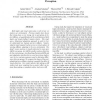132 search results - page 4 / 27 » Identifying Human Interactions in Indoor Environments |
HCI
2009
13 years 5 months ago
2009
Abstract. Social psychologists have documented that people attribute a humanlike agency to computers. Work in human motor cognition has identified a related effect known as "i...
HAPTICS
2007
IEEE
14 years 1 months ago
2007
IEEE
Both haptic and visual senses play a role in how we explore our environment. Previous studies have shown that vision plays a very strong role in perception of object stiffness, ye...
ISWC
2003
IEEE
14 years 20 days ago
2003
IEEE
We present a novel, inexpensive, coarse tracking system that determines a person’s approximate 2D location and 1D head orientation in an indoor environment. While this coarse tr...
FGR
2000
IEEE
13 years 11 months ago
2000
IEEE
A computer vision system for tracking multiple people in relatively unconstrained environments is described. Trackerformed at three levels of abstraction: regions, people and grou...
TOG
2002
13 years 7 months ago
2002
Real-time control of three-dimensional avatars is an important problem in the context of computer games and virtual environments. Avatar animation and control is difficult, howeve...

